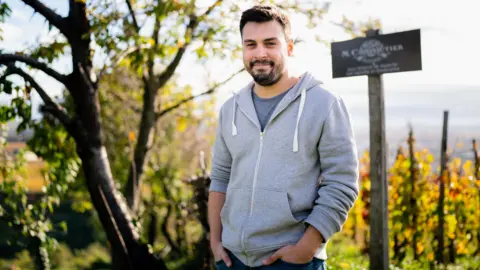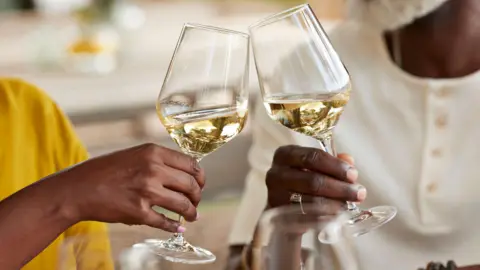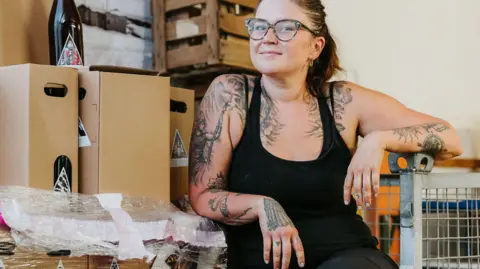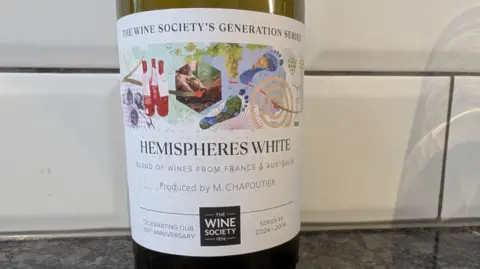Business reporter

 Chapoutier
ChapoutierWinemaker Maxime Chapoutier will be arrested if he tries to sell two of his latest wines in his native France.
“There will likely be anger about this type of wine in France, and that would be a good thing,” he says. “Sometimes you need to be provocative to drive change.”
The two bottles in question, one white and one red, would be illegal in France because they are made from a mixture of French and Australian wines.
Under French and EU law, it is prohibited to make wine that combines EU fruit with non-EU fruit. In France in particular, the authorities take such matters very seriously.
The French wine industry has a popular word called “terroir,” which applies to all the environmental factors that affect the growth of vines in a vineyard, such as soil, climate, and altitude. As a result, wines from a particular place are held in higher esteem.
Add a strict appellation or classification system for France’s wine regions, and the idea of blending French and Australian wines to create a global hybrid would terrify many French wine lovers.
However, Maxim did just that, and all thanks to one word – Brexit.
Because while it can’t sell both wines in the EU, it can do so in the UK now that London is no longer obligated to follow food and drink rules set by Brussels.
Maxime created the wines in partnership with UK online retailer The Wine Society, where they are called Hemispheres Red and Hemispheres White. The red is made from Syrah grapes, or Shiraz as they are called in Australia, while the white is a blend of Marsanne and Viognier varieties.
Australian red and white wine ingredients are shipped in bulk to the UK, where they are blended with wines from the northern Rhone and Roussillon regions of France before bottling.
Maxime, who works at his family’s famous Chapoutier wine company based in the Rhone region, says that while he respects France’s focus on terroir, there should be room to sell international blends as well.
“Chapoutier has been making wine for over 200 years, and is very driven by the terroir and biodynamics,” he says. “But more and more people are turning their backs on French wines because they do not understand the complex appellation rules.
“We need to adapt to consumers and make wine more accessible to everyone, which international blends can help do. Maybe EU law will change. It’s also environmentally better to ship wine from Australia to Europe in bulk, because you don’t have the capacity to.” Weigh all bottles.

 Getty Images
Getty ImagesAnother wine company that now makes wine by combining grapes from two continents is Australian company Penfolds. He sells red grapes made from Australian and California grapes, and other varieties that blend Australian and French grapes. Again, it cannot be sold in the EU, but it can be sold in the UK, US, Australia and elsewhere.
Penfolds refers to these blends as “wines of the world,” and says they “possess a difference that can best be described as worldly.” Whatever that was supposed to mean.
Unsurprisingly, some traditional winemakers do not support this development. One such person is Jas Swan, an independent winemaker based in Germany.
While Chapoutier and Penfolds’ two-continent blends are carefully crafted from high-quality grapes, and priced accordingly, she fears that if this trend increases, it will result in more cheap, low-quality wines coming up for sale.
“I think these wines will have nothing left of anywhere, even before they leave their continent,” she says. “This wine was only going to see machine work, heavy additives to keep it clean, and was made to be easy drinking for the masses.
“Why aren’t consumers more demanding? Consumerism is crazy.”

 Tapia Trichel
Tapia TrichelPeter Richards, the world’s highest qualified winemaker, Master of Wine (MW), is also a snob. “The idea of blending wines across the country is not something I find outrageous in and of itself,” he says. “What worries me most is that it is about creating modernity for the sake of modernity.”
“I’m still convinced that wine made by blending grapes from different countries can be great in taste,” adds his wife, Susie Barry, who also works at MW.
By contrast, wine writer Jamie Goode says developing wines on two continents “is actually a very interesting idea.”
“If the wines are good, well made from good vineyard sites – and not just a gimmick that blends cheap bulk wine and then puts a huge margin on the wine – that is very interesting.
“The basic foundation of fine wine is the idea of terroir – that the wine comes from somewhere, and its flavor expresses that place in unique ways. But not all wines have to be terroir, and there is room for wines like this.”
“In some ways, there’s a lot of skill required to blend the right wines together to create something interesting that comes from different places.”


Pierre Mansour, head of purchasing at The Wine Society, says he and his colleagues came up with the idea of making two wines made from grapes from different continents as part of the company’s 150th birthday celebrations.
“We were thinking about the future of wine, and we wanted to do something innovative. Ultimately we thought one area of innovation would be blending, which is creating wines that can mitigate the impact of climate change on a particular country.
“Because of the low-profile carbon footprint, it is more environmentally friendly to ship wine in bulk from Australia to the UK. But at the same time, we expected the ‘terrorists’ to say, ‘Holding on to this is fundamentally against the French principle of wine’.”
“So we reached out to Chapoutier, thinking they might say: ‘Are you crazy, how dare you insult us’, but they were great. They were really enthusiastic.”
https://ichef.bbci.co.uk/news/1024/branded_news/ce25/live/55bc65f0-d715-11ef-a7c6-03687bfc5dc1.jpg
2025-01-25 02:26:00







